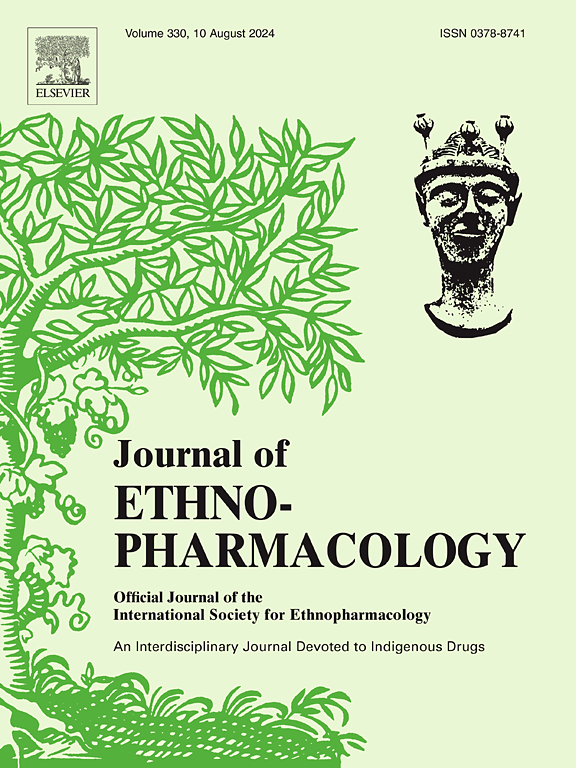结合生物信息学和多组学研究杜鹃花诱导肝毒性的机制。
IF 4.8
2区 医学
Q1 CHEMISTRY, MEDICINAL
引用次数: 0
摘要
民族药理学相关性:药物性肝损伤(DILI)是一种重要而常见的药物不良事件。杜鹃花(Rhododendron molle Flos, RMF)作为毒性中药之一,在临床治疗类风湿性关节炎中占有重要地位。然而,RMF的毒性限制了其安全性。对其快速神经毒性和心脏毒性的关注较多,对其肝毒性的关注较少,其作用机制尚不清楚。目的:利用生物信息学和多组学方法揭示rmf诱导肝毒性的机制。材料与方法:大鼠分别以0.8 g/kg、0.4 g/kg、0.2 g/kg剂量灌胃RMF,每日1次,连续2周。最初,用肝功能酶、抗氧化酶和组织病理学来评估肝毒性。随后,网络毒理学、转录组学和代谢组学被用于鉴定基因和代谢物。此外,采用分子对接和Western blot技术对毒理成分和关键靶点进行验证。结果:RMF引起大鼠血清中ALT、γ-GT、TBIL、TBA水平异常,肝脏中MDA、GSH-Px、SOD水平异常,导致肝细胞炎症浸润,且呈剂量依赖性。RMF扰乱了类固醇激素的生物合成、丙酮酸代谢、脂肪酸的生物合成和花生四烯酸的代谢。确定了UGT1A6、CYP2E1、ACOT1、ACSL5、CTH和plklr 6个关键靶点及其代谢产物,分别为17β-雌二醇、雌三醇、花生四烯酸、十八烷酸和丙酮酸。肝毒性可归因于五种二萜类成分,包括灰色毒素- iii,红参素(RJ)- 1, RJ- ii, RJ- iii和RJ- v。结论:本研究全面鉴定了rmf致肝毒性的毒性成分、上游靶点和下游代谢物,为临床应用中对患者肝功能的评价和监测提供了依据。本文章由计算机程序翻译,如有差异,请以英文原文为准。

Integrated bioinformatics and multi-omics to investigate the mechanism of Rhododendron molle Flos-induced hepatotoxicity
Ethnopharmacological relevance
Drug-induced liver injury (DILI) is an important and common adverse drug event. Rhododendron molle Flos (RMF), as one of toxic Traditional Chinese medicines (TCMs), holds a prominent position in clinical practice for treating rheumatoid arthritis. However, the toxicity of RMF limits its safe. Most of the concerns are about its rapid neurotoxicity and cardiotoxicity, with less attention paid to its hepatotoxicity, and the mechanism of which is still unclear.
Aim of the study
To reveal the mechanism of RMF-induced hepatotoxicity by bioinformatics and multi-omics.
Materials and methods
Rats were intragastric administered RMF at doses of 0.8 g/kg, 0.4 g/kg, and 0.2 g/kg once daily for 2 weeks. Initially, hepatotoxicity was then evaluated using liver function enzymes, antioxidant enzymes, and histopathology. Subsequently, network toxicology, transcriptomics, and metabolomics were used to identify the genes and metabolites. In addition, molecular docking and Western blot were employed to verify toxic components and key targets.
Results
RMF caused abnormal levels of ALT, γ-GT, TBIL, and TBA in the serum of rats, as well as abnormal levels of MDA, GSH-Px, and SOD in the liver, leading to inflammatory infiltration of liver cells, with a dose-dependent manner. RMF disordered the steroid hormone biosynthesis, pyruvate metabolism, fatty acid biosynthesis, and arachidonic acid metabolism. Six key targets were identified- UGT1A6, CYP2E1, ACOT1, ACSL5, CTH, and PKLR, along with their corresponding metabolites, namely 17β-estradiol, estriol, arachidonic acid, octadecanoic acid, and pyruvic acid. The hepatotoxicity could be attributed to five diterpenoid components, including grayanotoxin-III, rhodojaponin (RJ)-I, RJ-II, RJ-III, and RJ-V.
Conclusions
This study comprehensively identified the toxic components, upstream targets, and downstream metabolites of RMF-induced liver toxicity, providing a basis for evaluating and monitoring liver function in patients during clinical application.
求助全文
通过发布文献求助,成功后即可免费获取论文全文。
去求助
来源期刊

Journal of ethnopharmacology
医学-全科医学与补充医学
CiteScore
10.30
自引率
5.60%
发文量
967
审稿时长
77 days
期刊介绍:
The Journal of Ethnopharmacology is dedicated to the exchange of information and understandings about people''s use of plants, fungi, animals, microorganisms and minerals and their biological and pharmacological effects based on the principles established through international conventions. Early people confronted with illness and disease, discovered a wealth of useful therapeutic agents in the plant and animal kingdoms. The empirical knowledge of these medicinal substances and their toxic potential was passed on by oral tradition and sometimes recorded in herbals and other texts on materia medica. Many valuable drugs of today (e.g., atropine, ephedrine, tubocurarine, digoxin, reserpine) came into use through the study of indigenous remedies. Chemists continue to use plant-derived drugs (e.g., morphine, taxol, physostigmine, quinidine, emetine) as prototypes in their attempts to develop more effective and less toxic medicinals.
 求助内容:
求助内容: 应助结果提醒方式:
应助结果提醒方式:


